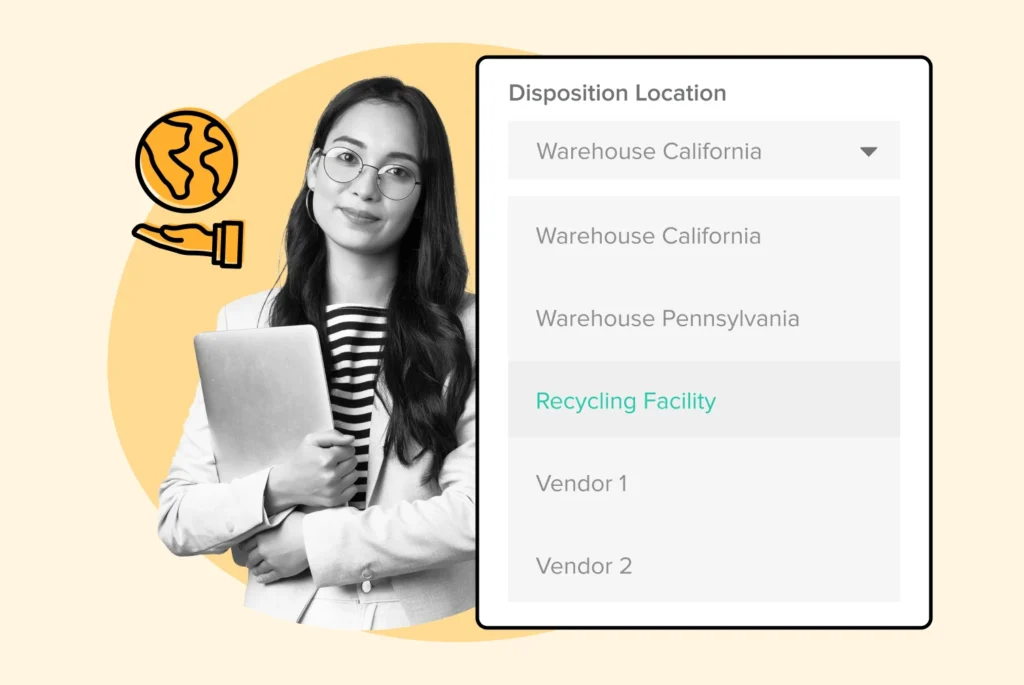
Navigating the Wave: The Bracketing Impact on Swimwear Industry and Solutions for Retailers
Learn how bracketing impacts the swimwear industry, from pricing strategies to consumer behavior. Learn what you need to navigate this trend!
Boost customer experience and reduce support tickets
Realtime order and shipment tracking
Proactive order and shipping notifications
Predictive pre-purchase estimated delivery dates
Self-Serivce branded order tracking
Effortless experience delivered
Make returns profitable and delight customers
Flexibility to define any return destinations & conditions
Simplify returns for your customers and team
Incentivize exchanges over returns
Returns management made easy for your team
Understand why your customers are returning
Unify the online and the in-store experience
Hassle-free pickup experience for customers
In-Store Dashboard to keep operations streamlined
In-Store and Online orders unified
Drive foot-traffic to your stores
Boost customer experience and reduce support tickets
Realtime order and shipment tracking
Proactive order and shipping notifications
Predictive pre-purchase estimated delivery dates
Self-Serivce branded order tracking
Effortless experience delivered
Make returns profitable and delight customers
Flexibility to define any return destinations & conditions
Simplify returns for your customers and team
Incentivize exchanges over returns
Returns management made easy for your team
Understand why your customers are returning
Unify the online and the in-store experience
Hassle-free pickup experience for customers
In-Store Dashboard to keep operations streamlined
In-Store and Online orders unified
Drive foot-traffic to your stores
Find the answer to all your questions
Explore the most comon questions about WeSupply
Calculate the ROI that WeSupply can bring you
Request a no strings attached review of your current shopping experience and missed conversion opportunities
Take a step by step trip through our functionality to see how we can improve your ecommerce processes.
Read actionable articles on how to optimize your post-purchase experience and decrease support tickets
Get inspired by stories of how our customers implemented an effortless post-purchase experience
A Deep Dive into Top Companies' Order Tracking & Returns Strategy
Wondering if WeSupply is a good fit for you? Read through our use cases to see how we can help you increase conversion & improve CX!

What does your inventory turnover ratio say about your business? This essential metric not only shows the frequency of selling and restocking but also highlights the efficiency and financial health of your operations. In this article, we demystify the inventory turnover ratio—how to calculate it, interpret it, and benchmark it effectively to improve your business strategy and meet industry standards. Gain actionable insights without getting lost in the complexity.
The inventory turnover ratio is a critical measure of a company’s efficiency and financial health, indicating how often inventory is sold and replaced within a specific period.
Optimal inventory turnover depends on balancing customer demand and product supply while minimizing waste from overstocking, which can be supported by robust inventory management systems and efficient management strategies.
Sector-specific trends and seasonal fluctuations should be considered when analyzing inventory turnover rates, with strategies for both high and low turnovers essential to optimize inventory levels and ensure business sustainability.
WeSupply enhances business operations by integrating analytics for logistics, shipments, and orders with efficient returns management, ensuring optimal inventory turnover. Automated restocking and detailed Returns Analytics help reduce return rates and refine offerings. Start with WeSupply to improve customer satisfaction and profit margins.
In the simplest terms, the inventory turnover ratio measures a company’s efficiency. The report provides information on:
How many times your inventory is sold and replaced
Helps to track inventory turnover over a specific period
This measure is a window into your company’s operational efficiency, financial health, and the overall success of your inventory management processes.
The computation of your inventory turnover ratio is quite simple. You just need to divide your cost of goods sold (COGS) by your average inventory during a specific duration. However, what constitutes a “good” inventory turnover ratio can vary significantly from one industry to another, making it essential to compare your ratios within your specific industry.
In the ecommerce realm, the management of inventory turnover is especially vital. Here, the stakes are high – high inventory turnover can suggest strong sales or insufficient inventory, while low turnover can imply weak sales or excess inventory.
Ecommerce businesses face unique challenges when it comes to inventory turnover. Unlike brick-and-mortar stores, online businesses often don’t have physical space constraints. This flexibility can lead to high storage costs and a greater risk of product obsolescence if inventory management isn’t efficient.
In ecommerce, efficient inventory turnover can mitigate these risks and identify issues with internal inventory control. This is where the use of robust inventory management systems comes into play, providing accurate sales data and stock forecasting features.
The inventory turnover ratio serves not only as a measure of efficiency but also plays a key role in evaluating a company’s overall business health. In industries where inventory forms a substantial part of a company’s assets, a low inventory turnover ratio can lead to significant risks, impacting the overall business health.
For instance, low inventory turnover in ecommerce can indicate excess inventory, supply chain issues, or weak sales due to lack of strategy or product-market fit. On the other hand, a high inventory turnover ratio is generally seen as positive, as it suggests that a company efficiently replaces inventory relative to its cost of sales. However, it’s crucial to consider various factors such as accounting policies, cost changes, and seasonal effects when evaluating the financial health of a company.
Examining the inventory turnover ratio closely uncovers its significance in multiple business decisions. Its interpretation can inform:
Pricing strategy
Manufacturing decisions
Marketing efforts
Purchasing policies
It also gives an insight into a company’s overall operational efficiency.
Yet, similar to any financial metric, the inventory turnover ratio doesn’t operate as an isolated performance measure. It needs to be viewed relative to industry norms and historical performance. A ratio that’s too high or too low could signify issues that need to be addressed.
For instance, a high inventory turnover ratio can suggest a need to raise prices, increase orders, diversify suppliers, or feature products more prominently in marketing. On the other hand, a slow inventory turnover can indicate decreased market demand and may necessitate changes in pricing, promotions, or inventory mix to realign with customer needs.
Comprehending the inventory turnover formula is essential for accurate interpretation. To calculate inventory turnover, the formula for Inventory Turnover Ratio is determined by dividing the Cost of Goods Sold (COGS) by the Average Inventory. This calculation helps businesses assess how efficiently they are managing their inventory. The COGS is preferred over sales in the formula because inventory is valued at cost, while sales include the company’s markup.
Average inventory is calculated by adding the beginning inventory and ending inventory values within the chosen timeframe and dividing it by two, offsetting seasonal effects. This calculation provides the average inventory value for the specified period.
Having grasped the basics of the inventory turnover ratio, we can now explore recent trends and ways to calculate inventory turnover ratio for your own business. Recent insights from CSIMarket for Q1 2023 show that retailers achieved an inventory turnover ratio of 11.92, indicating a complete inventory refresh more than 11 times annually.
However, not all sectors fare equally. Consumer discretionary brands, particularly in luxury attire, typically cycle through their inventory close to seven times each year. Perishable goods businesses, like grocery stores, tend to have higher inventory turnover ratios because their products have a limited shelf life, necessitating frequent restocking to avoid spoilage losses.
Interestingly, despite the general trend of high inventory turnover rates, some sectors have seen a decline. For example, S&P 500 companies in the following sectors have recorded lower rates of inventory turnover in the first quarter of 2023 compared to pre-COVID-19 levels:
Industrials
Healthcare
Information technology
Utilities
Consumer staples
A significant factor in these declining inventory turnover rates is attributed to the “supply chain bullwhip” effect, where companies over-ordered in response to shortages and elevated prices, leading to overstocking once demand slowed. This trend suggests that achieving the ideal inventory turnover ratio requires a careful balance between meeting customer demand and minimizing waste from over-ordering.
To analyze your inventory turnover ratio, you can use the inventory turnover ratio formula discussed earlier. A higher inventory turnover ratio suggests strong sales or potentially insufficient inventory to meet sales demand, while a lower ratio can indicate weak sales or an excess of inventory.
Seasonal fluctuations in sales can significantly impact inventory turnover ratios. Therefore, it’s important to consider using average inventory over a period to get a more stable and accurate measure.
WeSupply plays a crucial role in analyzing your inventory turnover ratio by offering a comprehensive view of your business’s logistics, shipments, order data, and returns. This integrative approach is vital for understanding the broader implications of your inventory management on business performance. By leveraging WeSupply’s detailed analytics, businesses can ensure they are making informed decisions, thereby highlighting the importance of proper business analytics in maintaining efficient operations and optimizing inventory levels.
Returns Analytics for eCommerce Business
Book a quick call with our experts to see how WeSupply can help you take analytics to the next level! Customers often return items because they were not satisfied with the product. Examining these returns can give businesses a lot of insight into what their customers want.
Though it’s important to comprehend your inventory turnover ratio, the ultimate objective lies in its optimization. Ensuring a high inventory turnover indicates good cash flow and strong demand for the company’s products.
Conversely, a low inventory turnover can signal problems such as slow restocking or overstocking of items that do not sell well.
Businesses can deploy numerous strategies to enhance their inventory turnover. Streamlining supply chain management can help businesses align inventory levels with actual customer demand, reducing the risk of overstocking and understocking.
Adjusting pricing and promotions can also help manage inventory turnover. For instance, hosting sales events such as clearance sales, flash sales, and seasonal sales can entice customers to purchase old or slow-moving inventory at reduced prices.
Moreover, enhancing forecasting and demand planning can also help businesses adapt to changing customer demands and prevent overstocking or understocking.
By utilizing WeSupply’s post-purchase tools, businesses can automate the restocking of inventory when products are returned. This feature not only streamlines operations but also ensures that inventory levels are maintained optimally, reducing the likelihood of overstocking or stockouts and thereby improving the overall inventory turnover rate.
The management of inventory turnover comes with its own set of challenges, often stemming from poor inventory management. From inconsistent inventory tracking across different software and spreadsheets, to warehouse efficiency being compromised by labor-intensive control processes, the hurdles can be numerous.
The key to overcoming these challenges lies in innovative strategies that streamline operations. For instance, centralized inventory tracking with cloud-based databases can deliver accurate, automatic updates and real-time data backups to overcome inconsistent tracking.
Improving warehouse efficiency is another area where businesses can make significant strides. By measuring and reporting metrics like inventory turnover, customer satisfaction, and order processing speed, businesses can identify inefficiencies and areas for improvement.
Employing inventory management software emerges as one of the most efficient solutions to these challenges. From automated reordering and procurement features to advanced demand forecasting and reporting features, inventory management software can transform inventory management by reducing manual effort and errors.
WeSupply addresses key challenges in inventory management by enhancing the post-purchase experience for online shoppers. This platform introduces vital enhancements to the online shopping experience with:
Proactive Alerts: Sends timely updates to customers about their order status, keeping them informed and engaged.
By utilizing innovative solutions like WeSupply, businesses can overcome common obstacles in inventory management, leading to improved operational efficiency and consistent growth.
Combat inconvenience with proactivity & self service
Book a quick call with our experts to see how WeSupply can help you make returns easy for your customers with a beautiful, self-service solution that makes their experience easier while also providing new ways to lower costs and earn back revenue.
A number of innovative strategies and practical applications exist to enhance inventory turnover.
One such strategy is to boost sales and reduce excess stock for low turnover. This can be done by implementing proper forecasting based on sales data, seasonal trends, and customer demographics.
For high turnover, ensuring adequate stock levels is crucial. This can be achieved by utilizing inventory automation software to manage stock levels efficiently and update inventory in real time, enabling quick restocking when necessary.
Creative marketing and sales tactics can also be a game-changer in improving inventory turnover. Implementing strategies like hosting sales events, improving product photography, and creating product bundles can increase product visibility and customer interest, thereby improving sales and inventory turnover.
Another innovative approach is leveraging product drops and pre-orders to optimize inventory levels. Implementing a “Back in Stock” alert system for out-of-stock products can gauge customer interest and use this data to forecast demand for future restocks.
Also, opening pre-orders for products not currently available can secure early sales and better predict the number of units to stock, ensuring a balance between supply and demand.
Even as the optimization of inventory turnover is vital, attention must also be paid to the role of returns in inventory management. Returns can significantly affect inventory turnover by either increasing stock levels unexpectedly or necessitating additional processes that may delay the sale of returned items.
Effectual management of returns can reduce their adverse effect on inventory turnover. Efficiently managing returns is crucial to maintaining a healthy inventory turnover rate, as high return rates can indicate issues with product quality, customer satisfaction, or the accuracy of product descriptions.
A streamlined returns process helps to quickly reintegrate returned items into inventory, minimizing the negative impact on inventory turnover.
WeSupply plays a pivotal role in mitigating the impact of returns on inventory turnover by streamlining the returns management process. By facilitating the immediate restocking of returned items, it helps maintain optimal inventory levels, ensuring that businesses can quickly redeploy products back into the sales cycle. This efficiency not only minimizes the negative effects of returns on inventory turnover but also enhances customer satisfaction by simplifying the post-purchase experience.
Furthermore, WeSupply’s Returns Analytics helps businesses understand why customers return items, identify patterns such as the most returned or exchanged products, and pinpoint serial returners. This data leads to actionable insights, enabling businesses to refine product offerings, streamline processes, and update return policies, ultimately reducing the return rate, improving profit margins, and maintaining customer satisfaction.
To conclude, attaining optimized inventory turnover necessitates a delicate balance. It requires a keen understanding of your business operations, customer demand, and market trends. While there isn’t a one-size-fits-all approach, the strategies outlined in this blog post, from leveraging inventory management software to optimizing pricing and promotions, can offer a roadmap to improved inventory management.
In summary, inventory turnover ratio is a vital financial measure that can influence the profitability of your ecommerce business. It provides insights into your inventory management, operational efficiency, and overall business health. By implementing the strategies discussed in this post, you can navigate the challenges of inventory management and optimize your inventory turnover ratio. Remember, the key to success is continuous improvement and adaptation to changing market demands.
WeSupply is integral to understanding the impact of your inventory turnover ratio on business operations. By providing comprehensive analytics on logistics, shipments, and order data, along with streamlined returns management, WeSupply ensures efficient supply chain management and optimal inventory levels. Its post-purchase tools automate inventory restocking when products are returned, directly influencing inventory turnover rates. Additionally, WeSupply’s Returns Analytics offer insights into the reasons behind returns, the most returned products, and customer return patterns, enabling businesses to reduce return rates through improved product offerings and processes. This holistic approach not only enhances customer satisfaction but also significantly impacts business growth by maintaining efficient inventory management and improving profit margins. Boost Your Business Efficiency Today: Start with WeSupply and Transform Your Inventory Management!
A good inventory turnover ratio is between 5 and 10 for most industries, indicating that you sell and restock your inventory every 1-2 months, striking a balance between inventory levels and reorder frequency.
To calculate the inventory turnover, use the formula: Cost of goods sold divided by average inventory. This ratio measures how many times average inventory is sold in a given period.
To improve your inventory turnover ratio, consider streamlining supply chain management, adjusting pricing and promotions, and enhancing forecasting and demand planning. These strategies can help optimize inventory turnover.
Returns play a significant role in inventory management by impacting inventory turnover and potentially increasing stock levels unexpectedly or causing delays in selling returned items. Be mindful of these factors when managing your inventory.
WeSupply offers comprehensive analytics that provide insights into logistics, shipments, and order data, facilitating an understanding of how inventory turnover affects business operations.
WeSupply streamlines returns management by automating the restocking of returned products, ensuring optimal inventory levels and directly affecting inventory turnover rates.
By providing detailed analytics and post-purchase tools, WeSupply ensures efficient supply chain management, helping businesses maintain optimal inventory levels and streamline their operational processes.
Learn How To Create Successful Post Purchase Email Campaigns
Build an effective post-purchase email flow that helps you increase customer satisfaction and drive revenue growth!
WeSupply is transforming the way businesses build Customer Lifetime Value by offering positive exchange experiences. By making exchanges effortless, WeSupply encourages customers to revisit your website for any product, without price constraints. Key features like using store credits or gift cards as partial payments not only increase order values but also reinforce customer loyalty. This approach is instrumental in enhancing Customer Lifetime Value, as it turns a simple exchange into a delightful shopping experience, fostering long-term customer relationships and ongoing business growth.

Learn how bracketing impacts the swimwear industry, from pricing strategies to consumer behavior. Learn what you need to navigate this trend!

How to handle post-purchase dissonance. Evidence-based strategies to alleviate dissonance, ensuring a smooth customer journey!

Keep your brand thriving when the market is strained: adapt your marketing, streamline operations, and enhance customer retention!

Let’s identify and dissect the best options ready to enhance your support system, with a focus on integration, experience, and scalability!

Let’s identify and dissect the best options ready to enhance your support system, with a focus on integration, experience, and scalability!

Keep your brand thriving when the market is strained: adapt your marketing, streamline operations, and enhance customer retention!

Discover tactics that satisfy both today’s buyers and tomorrow’s bottom line without compromising our planet’s health!

Revolutionize your business and lead the charge toward a greener e-commerce model: strategies for waste minimization & resource maximization!

Understanding mobile shopping trends is pivotal in today’s retail ecosystem. Stay ahead of them to navigate the evolution of mobile shopping!